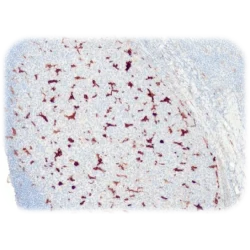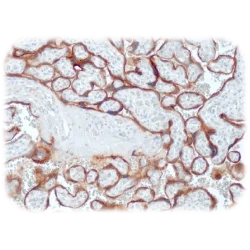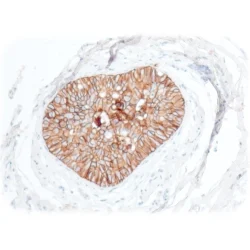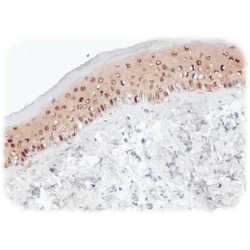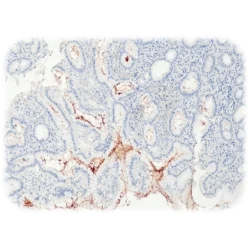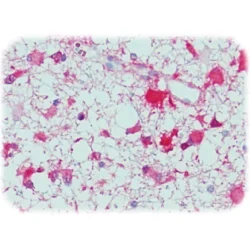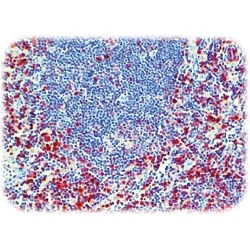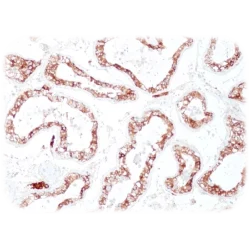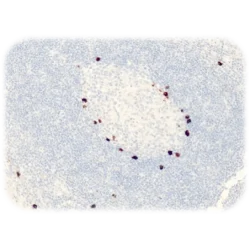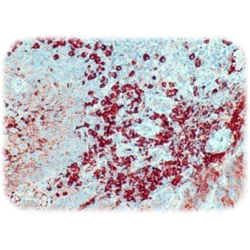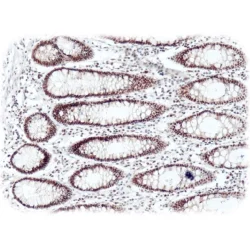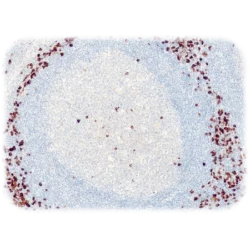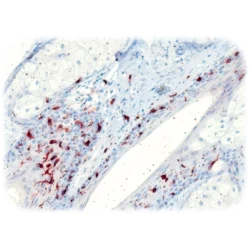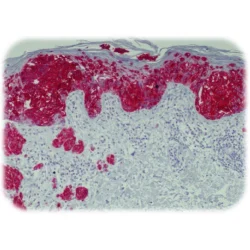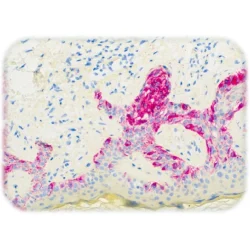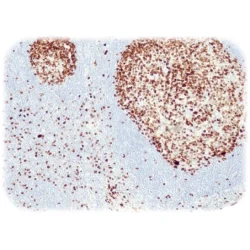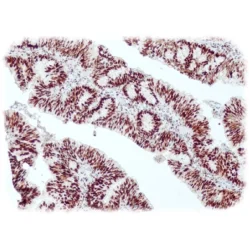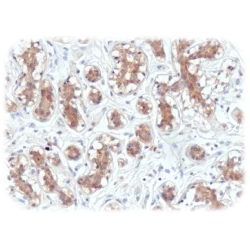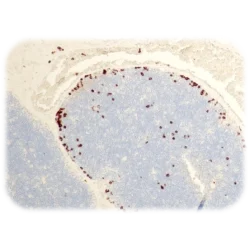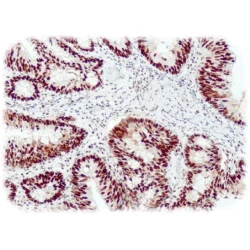دسته: آنتی بادیهای ایمونوهیستوشیمی
نمایش 861–880 از 923 نتیجه
فیلتر ها-
Quartett
آنتی بادی Glutamine Synthetase کلون QR090 برند Quartett
نمره 0 از 5Glutamine synthetase (GS) converts ammonia and glutamate to glutamine. Glutamine synthetase has multiple metabolic functions. Two of them are detoxification of ammonia, and regulation of glutamate in neurons. Synthesis and catalytic activity of glutamine synthetase are highly regulated.
-
Quartett
آنتی بادی Glypican 3 کلون QR103 برند Quartett
نمره 0 از 5Glypican 3 (GPC3) is a memer of glypican family of heparan sulfate proteoglycans that are anchored to the cell-surface via a covalent linkage to glycosylphosphatidylinositol. Glypicans can modify cell signaling pathways and contribute to cellular proliferation and tissue growth. Glypican 3 is a useful tumor marker for the diagnosis of hepatocellular carcinoma, hepatoblastoma, melanoma, testicular germ cell tumors, and Wilms tumor.
-
Quartett
آنتی بادی C-erbB-2(HER2) کلون QR003 برند Quartett
نمره 0 از 5Her2/Neu is a member of human epidermal growth factor family and encodes for a receptor tyrosine kinase involved in signal paths of growth factors.
Her2/Neu activation occurs in various tumors, mostly through gene amplification which results in high level overexpression. Her2/Neu amplification and overexpression is particularly common in breast cancer but can – at lower frequency – also occur in many other tumor entities. Numerous studies have demonstrated the prognostic relevance of Her2/Neu, which is overexpressed in 10% to 40% of human breast tumors. -
Quartett
آنتی بادی HSP70(Heat Shock Protein 70) کلون QR087 برند Quartett
نمره 0 از 5HSP70 is a heat shock protein of 70kDa. It prevents aggregation of other proteins in conjunction with other heat shock proteins and mediates folding of new proteins during synthesis.
-
Quartett
آنتی بادی Helicobacter Pylori کلون QR091 برند Quartett
نمره 0 از 5Helicobacter pylori (H. pylori) is a spiral-shaped, gram negative rod bacterium that is found in human stomach, despite there is an extreme acidic pH. Infections of gastric mucosa lead to gastric diseases like stomach ulcers or chronic gastritis. Furthermore, an infection with H. pylori is linked with the formation of gastric cancer and MALT lymphoma (MALT = Mucosa Associated Lymphoid Tissue). The antibody is useful for detecting the bacterial infection in gastric and duodenal epithelial cells.
-
Quartett
آنتی بادی IDH1 R132H(Isocitrate Dehydrogenase 1) کلون QM002 برند Quartett
نمره 0 از 5Isocitrate dehydrogenase 1/ IDH1 is an enzyme that catalyzes the third step of the citric acid cycle, which involves the oxidative decarboxylation of isocitrate, forming alpha-ketoglutarate and CO2 in a two-step reaction. The IDH1 protein is localized in the cytoplasm and in peroxisomes. It is expressed in a wide range of species and also in organisms that lack a complete citric acid cycle. Gliomas are the most frequent primary CNS malignancy.
The two common types of gliomas are astrocytomas and oligodendrogliomas. Three pathways of glioma development have been identified: primary glioblastomas that arise de novo without lower grade precursors, astrocytomas that start as grade II or III and then transform into secondary glioblastoma, or oligodendrogliomas that can transform into anaplastic oligodendroglioma.
IDH1 R132H point mutation is shown in more than 70 % of gliomas, frequently in WHO grade II and III gliomas and secondary grade IV glioblastomas.
The antibody QM002 is highly specific for the R132H point mutation allowing a diagnosis of astrocytomas or oligodendrogliomas.
The high rates of IDH1 mutations in oligodendroglial tumors make this mutation especially helpful for the differentiation of oligodendrogliomas from other tumors with clear cell appearance. IDH1 mutations have been shown to dominantly inhibit IDH1 catalytic activity.
Assessment of the IDH1 status may be performed by immunohistochemical detection of the mutated protein. In cases with negative or inconclusive immunostaining result further analysis by DNA-based methods is necessary. Testing of the IDH1 status is relevant for diagnostic and prognostic considerations in primary brain tumors. Mutated tumors generally show a better prognosis. -
Quartett
آنتی بادی IRTA1 کلون QM005 برند Quartett
نمره 0 از 5Immunoglobulin superfamily receptor translocation associated 1 (IRTA1) is a surface B-cell receptor related to Fc receptors, inhibitory receptor superfamily (IRS) and a cell adhesion molecule (CAM) family member. It is expressed by B cells near to glandular epithelium in the tonsil and Peyer patches and by monocytoid B cells. In lymphomas it is expressed by tumor cells involved in lymho-epithelial lesions.
Anti-IRTA1 is suitable for detection of marginalzone lymphomas in lymph nodes and extranodal locations. -
Quartett
آنتی بادی Inhibin Alpha کلون QR088 برند Quartett
نمره 0 از 5Inhibin down regulates FSH synthesis and inhibits FSH secretion. This antibody recognizes a protein of 32 kDa which is identified as Inhibin alpha. It helps in the differentiation between adrenal cortical tumors and renal cell carcinoma and it detects sex cord stromal tumors of the ovary as well as trophoblastc tumors.
-
Quartett
آنتی بادی IgG4 کلون QR092 برند Quartett
نمره 0 از 5Immunoglobulin G is the most abundant antibody isotype found in the circulation. Human IgG4, one of four subclasses of IgG, contains a gamma 4 heavy chain and a hinge region that is shorter than that of IgG1. The two primary effector functions are activating complements and binding to the FcgR of effector cells to initiate phagocytosis. Human IgG4 accounts for less than 6 % of the total IgG serum level. IgG4-related sclerosing disease has been recognized as a systemic disease entity characterized by an elevated serum IgG4 level, sclerosing fibrosis, and diffuse lympho-plasmacytic infiltration with the presence of many IgG4-positive plasma cells. IgG4 is overexpressed in inflammatory pseudo-tumor (IPT) and under expressed in inflammatory myofibroblastic tumor (IMT). In pulmonary nodular lymphoid hyperplasia (PNLH), there are an increased number of IgG4+ plasma cells.
-
Quartett
آنتی بادی Kappa Immunoglobulin Light Chain کلون QR051 برند Quartett
نمره 0 از 5B lymphocytes produce immunoglobulins consisting of two identical heavy chains and either two identical kappa light chains or lambda light chains. Normal lymphoid tissues therefore contain a mixture of B cells that express kappa and lambda light chains in a ratio of 2:1. This ratio is lost in tumors of B cell origin as they arise from one transformed cell, and thus only one type of light chain is expressed. The monoclonality of malignant lymphoma is used as diagnostic marker in detection with Kappa Light Chain antibody. This antibody labels kappa light chains of human immunoglobulins expressed by B lymphocytes and plasma cells. It may be helpful in detection of leukemia, plasmacytoma and various non-Hodgkin lymphoma. Other cells may also express kappa light chains resulting from non-specific immunoglobulin uptake. Kappa light chain antibody may be used in a panel with Lambda light chain.
-
Quartett
آنتی بادی MLH1 کلون QM003 برند Quartett
نمره 0 از 5DNA mismatch repair (MMR) system consists of four major proteins called MLH1, MSH2, MSH6, and PMS2. These proteins work two by two, MLH1 with PMS2 and MSH2 with MSH6. Loss of function of one of the four proteins leads to inactivation of the MMR system, resulting in a loss of fidelity of the replication and an accumulation of mutations thereby leading to microsatellite instability (MSI).
MSI is associated with hereditary nonpolyposis colorectal cancer (HNPCC, Lynch syndrome), which is characterized by the development of colorectal cancer, endometrial cancer and various other tumors at early age.
Loss of MLH1 function due to gene mutation or epigenetic changes is characterized by absence of nuclear expression in neoplastic cells, whereas intact nuclear MLH1 expression indicates normal MLH1 function and no gene mutations. MLH1 is normally expressed in most cases of sporadic colorectal cancer, loss of MLH1 expression is found in 30-40%.
Anti-MLH1 is useful in detection of MSI, especially in a panel with MSH6 (QR011), PMS2 (QR009) and MSH2 (QR010). -
Quartett
آنتی بادی Lambda Immunoglobulin Light Chain کلون QR052 برند Quartett
نمره 0 از 5B lymphocytes produce immunoglobulins consisting of two identical heavy chains and either two identical kappa light chains or lambda light chains. Normal lymphoid tissues therefore contain a mixture of B cells that express kappa and lambda light chains in a ratio of 2:1. This ratio is lost in tumors of B cell origin as they arise from one transformed cell, and thus only one type of light chain is expressed. The monoclonality of malignant lymphoma is used as diagnostic marker in detection with lambda light chain antibody.
This antibody labels lambda light chains of human immunoglobulins expressed by B lymphocytes and plasma cells. It may be helpful in detection of leukemia, plasmacytoma and various non-Hodgkin lymphoma. Other cells may also express lambda light chains resulting from non-specific immunoglobulin uptake. Lambda light chain antibody may be used in a panel with kappa light chain. -
Quartett
آنتی بادی CD207(Langerin) کلون QR065 برند Quartett
نمره 0 از 5Calcium-dependent (C-type) lectins are a family of lectins which share structural homology in their high-affinity carbohydrate-binding domain. Proteins of the CLEC superfamily function in a variety of biological processes, including cell adhesion, cell-cell signaling, glycoprotein turnover, apoptosis, inflammation, and immune response to pathogens. CLEC4K/Langerin is a type II membrane associated receptor expressed exclusively by Langerhans cells, in astrocytoma, malignant ependymoma, but not in normal brain tissues. It recognizes mannose residues, induces membrane superimposition and zippering leading to formation of Birbeck granules. Defects in CLEC4K cause Birbeck granule deficiency, a condition characterized by the absence of Birbeck granules in epidermal Langerhans cells.
-
Quartett
آنتی بادی MELAN A(MART1) کلون A103 برند Quartett
نمره 0 از 5Melan A (A103), also known as MART-1 (melanoma antigen recognized by T-cells 1), is an important immunohistochemical marker for the diagnosis of maglignant melanoma. The protein is expressed on the surface of melanocytes and is located in normal skin, retina and nevi.
-
Quartett
آنتی بادی Melanoma کلون HMB-45 برند Quartett
نمره 0 از 5Melanoma (HMB-45) reacts against an antigen present in melanocytic tumors and is absolute specific for melanoma. The antibody stains fetal and neonatal melanocytes, junctional and blue nevus cells, and malignant melanocytes. Intradermal nevi, normal adult melanocytes, and non-melanocytic cells are negative. It does not stain tumor cells of epithelial, lymphoid, glial, or mesenchymal origin.
-
Quartett
آنتی بادی KI67 کلون QR015 برند Quartett
نمره 0 از 5Ki-67 is a nuclear protein expressed in all proliferating cells, which are in active phases of cell cycle (late G1, S, G2, mitosis). Ki-67 is not detected in resting cells (G0 phase). Thus, the antibody is a general proliferation marker, especially used to assess the proliferative activity of a tumor. Different cancer types express Ki-67, including breast, prostate, lung, and colon.
-
Quartett
آنتی بادی MSH6 کلون QR011 برند Quartett
نمره 0 از 5DNA mismatch repair (MMR) system consists of four major proteins called MLH1, MSH2, MSH6, and PMS2. These proteins work two by two, MLH1 with PMS2 and MSH2 with MSH6. Loss of function of one of the four proteins leads to inactivation of the MMR system, resulting in a loss of fidelity of the replication and an accumulation of mutations thereby leading to microsatellite instability (MSI). MSI is associated with hereditary nonpolyposis colorectal cancer (HNPCC, Lynch syndrome), which is characterized by the development of colorectal cancer, endometrial cancer and various other tumors at early age.
Loss of MSH6 function due to gene mutation or epigenetic changes is characterized by absence of nuclear expression in neoplastic cells, whereas intact nuclear MSH6 expression indicates normal MSH6 function and no gene mutations. MSH6 is normally expressed in most cases of sporadic colorectal cancer, loss of MSH6 expression is found in 2-16%.
Anti-MSH6 is useful in detection of MSI, especially in a panel with MSH2 (QR010), PMS2 (QR009) and MLH1 (QM003). -
Quartett
آنتی بادی Mammaglobin A & B کلون QR080 برند Quartett
نمره 0 از 5Mammaglobin is a 10 kDa glycoprotein that is associated to breast. A correlation between increased expression of mammaglobin gene and breast cancer has been reported.
-
Quartett
آنتی بادی MPO(Myeloperoxidase) کلون QR101 برند Quartett
نمره 0 از 5Myeloperoxidase is a peroxidase enzyme. This antibody detects granulocytes and monocytes in blood and precursors of granulocytes in the bone marrow. In normal tissues and in a variety of myeloproliferative disorders myeloid cells of both neutrophilic and eosinophilic types, at all stages of maturation, exhibit strong cytoplasmic reactivity for MPO. Erythroid precursors, megakaryocytes, lymphoid cells, mast cells, and plasma cells are nonreactive. MPO is not observed in the neoplastic cells of a wide variety of epithelial tumors and sarcomas. MPO is useful in differentiating between myeloid and lymphoid leukemias.
-
Quartett
آنتی بادی MSH2 کلون QR010 برند Quartett
نمره 0 از 5DNA mismatch repair (MMR) system consists of four major proteins called MLH1, MSH2, MSH6, and PMS2. These proteins work two by two, MLH1 with PMS2 and MSH2 with MSH6. Loss of function of one of the four proteins leads to inactivation of the MMR system, resulting in a loss of fidelity of the replication and an accumulation of mutations thereby leading to microsatellite instability (MSI). MSI is associated with hereditary nonpolyposis colorectal cancer (HNPCC, Lynch syndrome), which is characterized by the development of colorectal cancer, endometrial cancer and various other tumors at early age.
Loss of MSH2 function due to gene mutation or epigenetic changes is characterized by absence of nuclear expression in neoplastic cells, whereas intact nuclear MSH2 expression indicates normal MSH2 function and no gene mutations. MSH2 is normally expressed in most cases of sporadic colorectal cancer, loss of MSH2 expression is found in 13-40%.
Anti-MSH2 is useful in detection of MSI, especially in a panel with MSH6 (QR011), PMS2 (QR009) and MLH1 (QM003).

